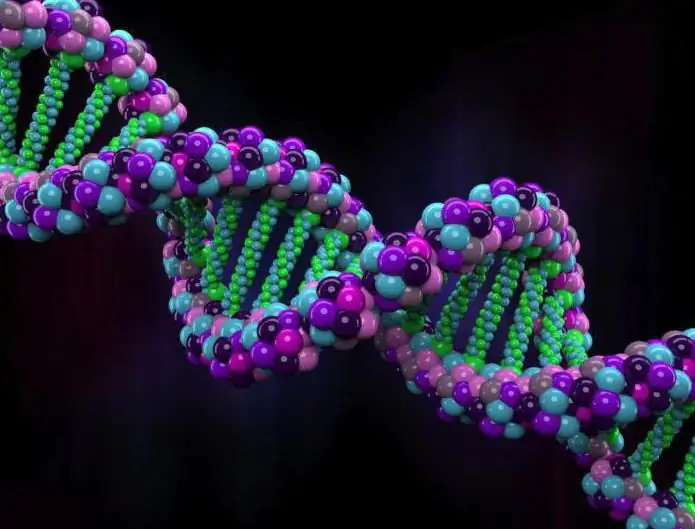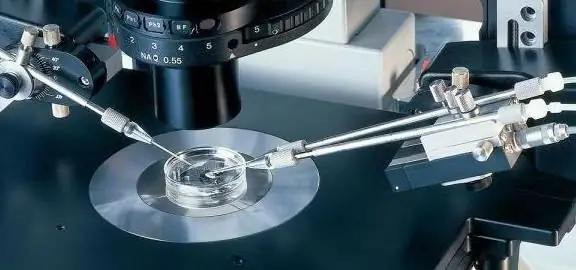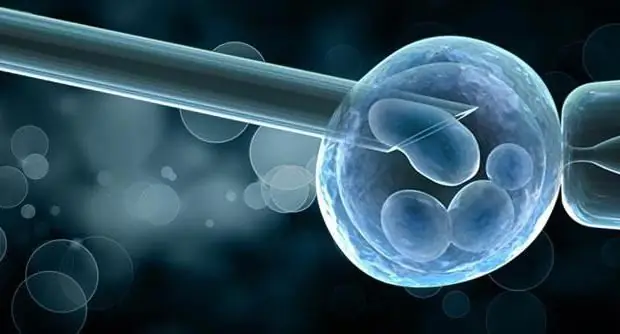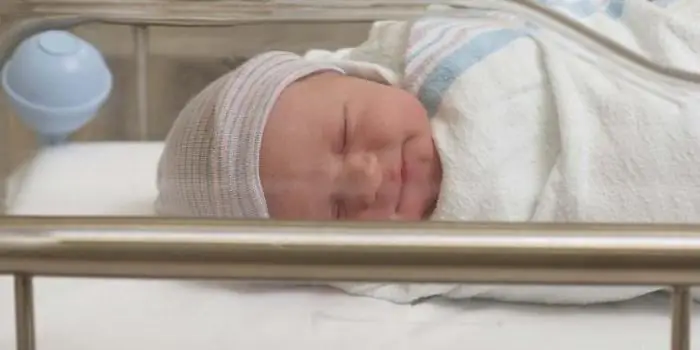- Author Curtis Blomfield [email protected].
- Public 2023-12-16 20:44.
- Last modified 2025-01-23 17:01.
The method of pre-implantation genetic diagnosis is used to assess the he alth status of an embryo obtained by in vitro fertilization before implantation into the uterine cavity. The method allows not only to choose a he althy future baby, but also to increase the chance of pregnancy. The technique is widely used in all world clinics involved in in vitro fertilization.

General concepts
Pre-implantation genetic diagnosis allows you to conduct a comprehensive examination and exclude the presence of chromosomal abnormalities in general or any one specific deviation. Recently, in parallel with early defects, genes are being screened that can provoke the onset of tumors in adulthood (ovaries, intestines, breasts).
In the case of a carrier of genomic diseases on the mother's side, a biopsy of several polar bodies of the egg is performed even before fertilization. The described methods are an alternative to early prenatal diagnosis, which allows you to warn against abortion if the fetus suddenly has genetic pathologies.
Pre-implantation genetic diagnosis allows you to determine the sex of the future baby already in the process of screening. This is used to prevent the development of gender-linked anomalies.
How genetic diseases are inherited
Distinguish between hereditary pathologies that have arisen according to the dominant, recessive and x-linked type.
| Inheritance type | Features | Risk of having a sick baby |
| Dominant | One of the partners has one defective gene that is dominant in their pair | 50% inherit gene |
| Recessive | Both partners carry the same defective gene but have a normal pair | 50% become a carrier, 25% get the disease |
| X-linked | Women are protected from pathology by their set of chromosomes and are exclusively carriers. Men are characterized by the development of an anomaly | a man has a 50% chance to inherit a gene and a disease, a woman has a chance to become a carrier like her mother - 50% |
Who is being screened?
Pre-implantation genetic diagnosis (PGD) is performed in the following cases:
- The presence of one or both of the couple of hereditary diseases or changes in the karyotype. Often the partners themselvesknow about their problems, less often they find out during the screening process.
- Recurrent miscarriage. The problem of this is not anomalies on the part of the parents (they may not be at all), but the genetic mutations of the fetus that cause miscarriages.
- The age of persons undergoing IVF program is over 38 years old.
- History of more than 3 failed IVF attempts.
- Male infertility.
- Inclusion of ICSI (intracytoplasmic sperm injection) in the fertilization program. The process is fraught with the development of genetic abnormalities in the embryo.
- History of hydatidiform mole.

Features of PGD
Research in the field of preimplantation genetic diagnosis suggests that the method has the right to exist, helps to diagnose and prevent chromosomal abnormalities, however, requires further improvement.
Features of PGD are as follows:
- rate of miscarriage with screening is lower than without it;
- there is currently no evidence that increases the chance of pregnancy;
- there is a possibility of a false result: the embryo is he althy, but the result shows deviations, the embryo is sick, but the study says otherwise (5-10% of cases).
Pre-implantation genetic diagnosis (blastomere examination)
After the agreement for in vitro fertilization, the reproductive specialist evaluates the needPGD for a married couple. If indicated, the partners may agree or refuse the procedure. Next, a document is signed confirming permission to conduct the survey.

On the third day after the fertilization of the embryo, the geneticist takes one of the formed blastomere cells for analysis. It is believed that this has no consequences for the fetus, since all cells are interchangeable.
The specialist conducts research in one of the previously selected areas: studying the structure of the cell under a special fluorescent microscope, DNA testing using the polymerase chain reaction method to determine the presence of a mutation.
Based on the result, embryos with abnormalities will not be used in the implantation process. Selected he althy and high quality. Then one or more of them are transferred to the mother's uterus.
When a biopsy of the polar body occurs, the chromosome set of the mother is examined. It is carried out in the event that the presence of a genetically determined pathology is revealed along the female line. The procedure allows you to determine whether the egg is he althy, which will be used for fertilization, without violating its structure. If no abnormalities are detected, then it can be used for fertilization and transfer to the uterine cavity.
There are cases when polar bodies are screened, and then blastomeres. This allows you to get a more reliable result. The scheme according to which the examination will be carried out is chosen by the specialistgeneticist.

Methods used
Numerical and structural abnormalities of chromosomes are determined by the method of fluorescent hybridization. This method allows you to specify the DNA sequence of the cell. Special DNA probes are used, which in their structure are complementary sites for blastomere DNA zones.
The probe contains a nucleotide and a fluorophore (a molecule capable of fluorescence). After the interaction of the target DNA with the DNA probe, illuminated areas are formed, which are viewed under a fluorescent microscope.
Also use the PCR method (polymerase chain reaction). It consists in copying a section of DNA using enzymes under certain laboratory conditions.
Diagnosis of aneuploidy
This is one of the methods of pre-implantation genetic diagnosis, which allows to detect the presence of numerical chromosomal abnormalities (identify extra or missing chromosomes).
Genetic material consists of 46 chromosomes, half of which are given by the father and the other half by the mother. If the embryo receives an extra chromosome, it is called trisomy, and the loss of any is called monosomy. These defects can result in:
- lack of embryo implantation;
- miscarriage;
- hereditary pathologies (Down syndrome, Klinefelter, Shereshevsky-Turner syndrome).

Male infertility and couple ageare frequent factors in the development of such anomalies.
PGD of monogenic pathologies
Pre-implantation genetic diagnosis of embryos in order to determine the presence of monogenic diseases is carried out in families where the presence of hereditary anomalies has been established. If a married couple already has a baby with a homogeneous disease, then the opportunity to give birth to another sick child increases several times.
The cause is a violation of the sequence of chromosomes in a certain section of DNA. These diseases include:
- cystic fibrosis;
- adrenogenital syndrome;
- phenylketonuria;
- hemophilia;
- sickle cell anemia;
- Wernig-Hoffman syndrome.
Benefits and risks of the method
Pre-implantation genetic diagnosis, which is considered ambiguous, has certain advantages in prenatal screening:
- only high-quality and he althy embryos are transferred to the uterus;
- reduces the risk of having a baby with genetic abnormalities;
- halve the risk of miscarriage;
- halving the risk of multiple pregnancy;
- 10% more chance of embryo implantation;
- 20% increase in the chance of a successful birth of a baby.
The risk of inadvertent damage to the embryo during PGD is 1%. The probability of an erroneous result is 1:10, in addition, a 3% chance that an embryo with any anomaly will be judged as he althy.
Probability that a he althy embryo will havedeviations - 1:10. 1:5 chance that the transfer of embryos into the uterine cavity will be canceled due to the found anomalies in each of them.

Contraindications
Pre-implantation genetic diagnosis (PGD), the consequences of which for the embryo have not been clearly identified, has a number of contraindications to conduct:
- embryo fragmentation more than 30% (the formation of fragments up to 25% is considered the norm);
- presence of multinucleated blastomeres in the embryo;
- embryo has less than 6 blastomeres on the third day of its development.
Method security
Diagnosis is carried out at an early stage of creating a future organism, when all its cells are pluripotent, that is, a full-fledged he althy organism can form from each.
All ongoing PGD steps do not cause time to the embryo, fetus and unborn baby. After the sample for research is received, it is prepared in a special way. Cells are placed on a glass slide, on which they are fixed, or in a buffer solution.
Cost of procedure
Pre-implantation genetic diagnosis, the cost of which varies from 50 to 120 thousand rubles, at first glance, seems like an expensive manipulation. However, the he alth and treatment of a child with genetically determined pathologies will cost much more.

The procedure gives all the advantages over women who were able to conceive a child naturallyway, since such a diagnostic method is not available to them. Pre-implantation genetic diagnosis, the price of which is negligible in comparison with in vitro fertilization itself, serves only as an addition to the general program that allows not only to endure and give birth, but also to raise a he althy baby.






